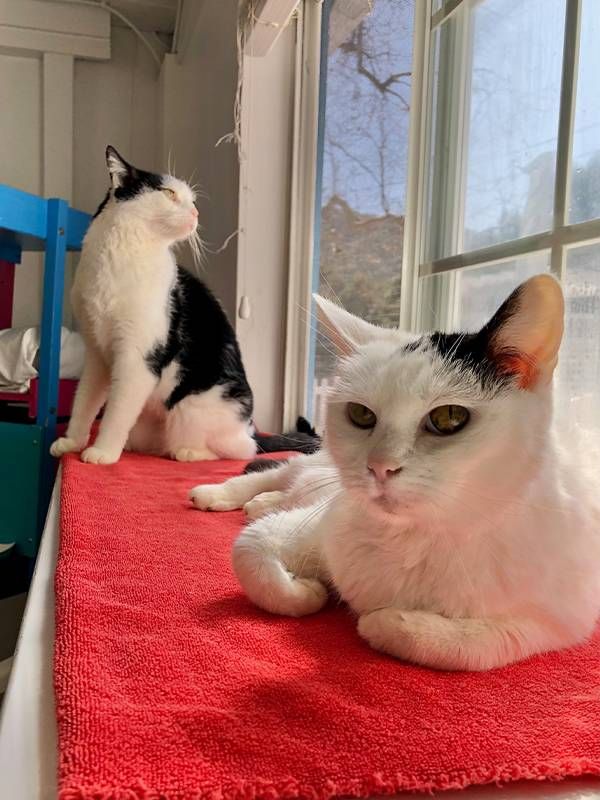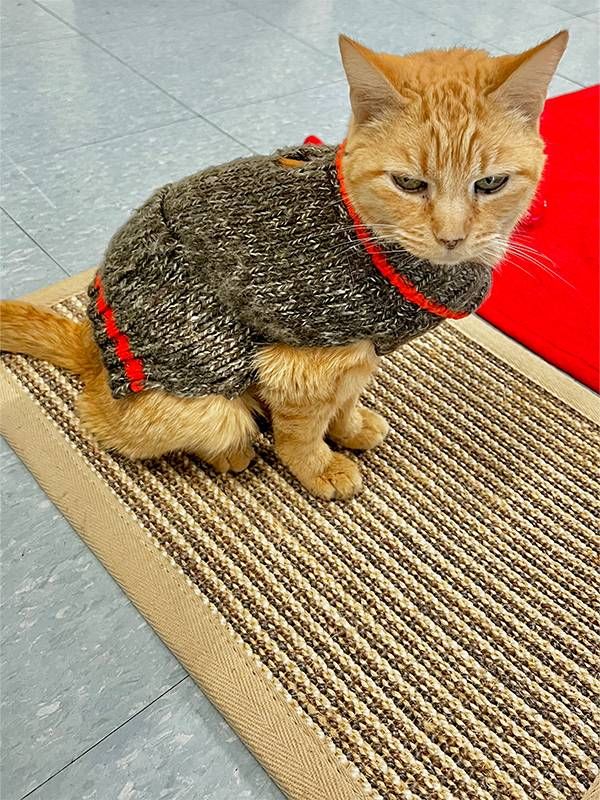Finding Caring Homes for Older Pets
Organizations across the country are working to provide homes for pets whose owners have died, and why it's important to include pets in your estate plan
Joey and Mary Jane, two older cats with panda-like patches, once lived the good life with their owner, a pet sitter. Then the unthinkable happened: the woman fell ill and died, landing the two in a shelter. Lucky for them, their owner's friends and clients donated enough money to send the siblings to Blue Bell Foundation for Cats, a Laguna Beach, California cat retirement home.

On the day I visited Blue Bell, Mary Jane peered at me from high in her preferred cat cubby while little brother Joey snuggled on a sofa below with staffer Jenna, now his favorite human. Other cats wandered in and out of the large, sunlit rooms filled with cozy cat houses, fluffy beds, scratching posts and toys.
Blue Bell's quaint 100-year-old cottage has sheltered thousands of older cats since it opened as a sanctuary in 1989. But across the U.S., less fortunate older pets are packed into cages. Odds are grim that they'll find a new home. Although cats (79 million) are outnumbered by dogs (108 million) overall, 68% of the 355,000 animals euthanized in U.S. shelters each year are cats, most of them older.
Older pets are usually the last to be adopted out, and the first to be euthanized.
Older pets are usually the last to be adopted out, and the first to be euthanized. Susan Hamil has seen it all, in three decades with Blue Bell, where she is now executive director. "Too many times, [after the owner dies], the cat is dumped at a shelter," she says.
According to American Pet Products Association, 70% of U.S. households in 2021 included a pet, and numerous studies point to health benefits of pet ownership. However, during the pandemic, when more than a million Americans died and millions more fell ill, shelters grew inundated with abandoned pets. Costs for food and veterinary care also climbed sharply, beyond what many could afford.
Pets now live longer than in decades past, thanks to advances in care. And their human parents are more likely to be childless or living far away from family than previous generations, leaving fewer options when an owner dies or becomes disabled.
"The pandemic has been a wake-up call for many pet owners," says Hamil. When she first started with Blue Bell, they'd field five or six calls a year about estate plans. "Now we get that many every week, asking, 'What do I do with this cat?'"
Why It's Important to Make Plans
I learned about this dilemma firsthand when a dear friend passed away only weeks after her cancer diagnosis, too ill to make plans for her two mature cats. When I reached out to a long list of rescue groups, I heard anguish and desperation. "We're at 150% capacity," one told me, with her apologies. "We barely have room for kittens," said another. "We cannot afford to take any more older cats."
My friend's family eventually found the cats a good home, but the experience jolted me: what would happen to my own three senior cats in a situation like this? When my husband and I wrote our will, years ago, the attorney didn't even mention our pets.

The majority of Blue Bell's cats come to them through the owner's estate planning, but the price can be steep: Blue Bell asks for a bequest of $10,000 for a 12-year-old cat, but if the cat is much older, the price drops, since the cat will likely need fewer years of care.
"We lose money even at that price," says Hamil. "We have strong community support and donors who make up the difference."
Blue Bell's cats arrive from all over: elegant calico Sabrina flew from Georgia with her mom, a woman nearing death who nevertheless stayed for weeks to help Sabrina transition to her new home. Other cats lost owners in Chicago and Baton Rouge, Louisiana.
And then there are the "community cats," such as Clarence, a grizzled gray tabby charity case; they make up 10-20% of Blue Bell's population. A year ago, some students rescued him and took him to a city shelter that then reached out to Blue Bell.
Clarence, who needed treatment for a large tumor, took to the sanctuary within days, fitting in easily with the other residents – not always the case with cats. Blue Bell keeps its new arrivals and less socialized cats in solo but roomy enclosures, to ensure the safety of all.
These days, Blue Bell keeps a maximum of 50 cats, and was down to 35 the day I visited. Hamil has seen too many rescue groups get overwhelmed by the constant, urgent need. "Everyone starts with good intentions, says Hamil. "Rescues have to learn to say no. You can't save them all."
Researching Options
Hamil cautions pet owners to thoroughly research any sanctuary and go beyond online ratings. Though Blue Bell is licensed by local animal control, there is no central organization that oversees pet sanctuaries, and therefore there are no requirements involving funding or operations. Hamil says to look up board members, check the financial records, speak to the veterinarians who provide care, and ask animal control if they make regular inspections.
As spay/neuter programs have reduced the number of new unwanted pets, shelters and rescue groups have begun turning their attention to solving this thorny issue of older pets. Hamil stays in contact with an informal network loosely organized by Best Friends Animal Society in Kanab, Utah. Best Friends, the largest sanctuary for companion animals in the U.S., has 4000 partners, and has created many pet-saving programs now used by shelters nationwide.
When my husband and I wrote our will, years ago, the attorney didn't even mention our pets.
Brent Toellner, senior director of lifesaving programs for Best Friends, began his work with city shelters in Kansas City, Missouri, where in 2010, the shelters euthanized 65% of its incoming animals. With Toellner's help, that number dropped to 10% in just one year.
Toellner joined Best Friends and its "No Kill 2025" initiative, with a goal to increase the animal "save rate" to 90% at every shelter in the U.S. by the year 2025. Best Friends provides grants and guidance on ways to reach that goal through foster, adoption and spay programs.
There's still work to be done, says Toellner. "A thousand cats and dogs are still dying unnecessarily in shelter systems every day."
Toellner recommends a three-part plan for your pets: First, make sure you have an emergency caregiver who knows your wishes and can provide immediate care and support. Second, identify a permanent caregiver, that person or a sanctuary able and willing to provide long-term care. Third, if possible, leave money to cover your pet's long-term care. Your will or trust should also mention the transfer of your pets, with detailed instructions.
Best Friends has only a few animals they take in due to estate planning: its primary focus is to help dogs and cats already in the shelter system.
"Animals that come to us weren't thriving, and needed a place to call home for short-term medical or behavioral issues. All of our brick and mortar facilities have foster systems set up to expand capacity," Toellner says, but "there is always more demand for our services than we have the capacity to keep up with." And Toellner himself is fostering a dog, temporarily, who will return to its family once they are settled in a permanent home.
Help for Abandoned Pets
Five states – Alabama, California, Florida, North Carolina and Texas - account for half of all dogs and cats euthanized in U.S. shelters. Texas is the worst: its shelters euthanized 61,425 animals in 2021. But in the tiny town of Bertram, population 1764, Rhonda Minardi is working hard to reverse those numbers. Minardi hopes her shelter, Living Grace Canine Ranch (LGCR), will be a guiding light for others eager to help older and special needs dogs.

Minardi, a health care worker, was inspired into action when she learned that two thirds of the dogs in her local shelter were orphaned or abandoned older dogs. On a leap of faith, she took out a loan to buy land and set up a nonprofit. LGCR now has two buildings, eight staffers, and a medical clinic, with nearly 60 volunteers helping care for 138 dogs.
Minardi realized that age bias and fear of financial expense are two key reasons older pets languish in shelters. So she created Forever Foster, providing food and medical care when local older adults foster LGCR's dogs. If the foster parent moves into assisted living, the dog returns to LGCR – with visits still scheduled with the foster, when possible. One dog, Delaney George, became so popular during his facility visits that the management decided to adopt him.
Minardi urges people not to wait to talk with family and friends. "We plan to give our grandchildren our china," she says. "But what about the pets? Don't assume your kids will take care of them. More than 80% of time, they will take those pets down to the shelter."
Until talking with these experts, I also assumed my own pets would die before me. It's comforting to know there are places like Blue Bell, where cats romp freely inside, with screened "catios" giving them active views of birds and wildlife in the gardens.
Or maybe a friend or family member will agree to be my back-up plan, leaving room open at a sanctuary for another pet in need. Hamil is encouraged by pet owners working on solutions, including a "cat club" in a nearby retirement community, where members agree to take in the orphaned cats of other members.
During my Blue Bell visit, the more gregarious cats sniff my boots and jump up beside me, one by one, angling for attention. A thin ginger named Honey sashays past, a one-kitty fashion show in her favorite chunky sweater. All my cats are rescues, seemingly allergic to cages. And though I hope my passing is a long way off, I can almost picture them here, lounging in the sun or strutting around in their own fashion, enjoying a soft landing in a place where they're loved and valued.


